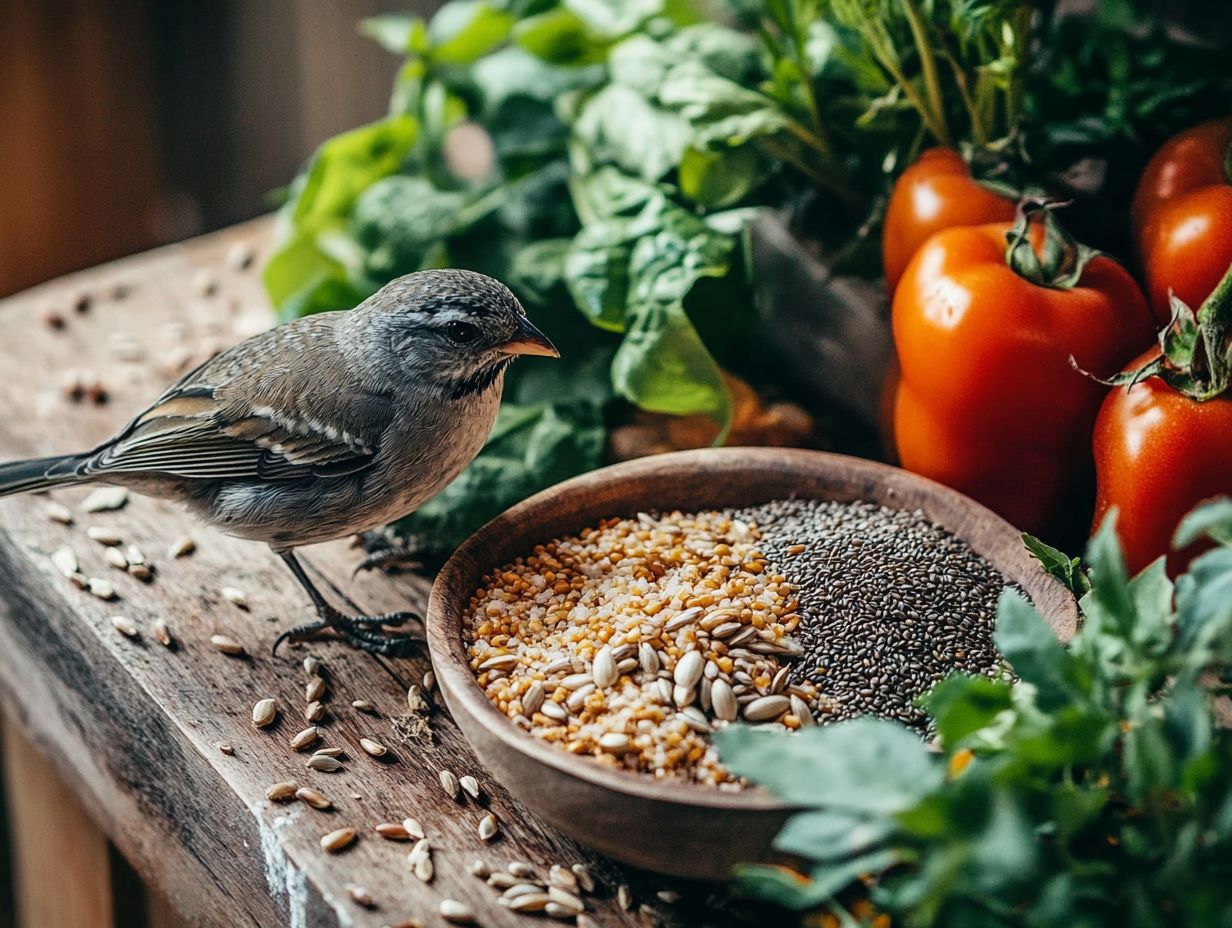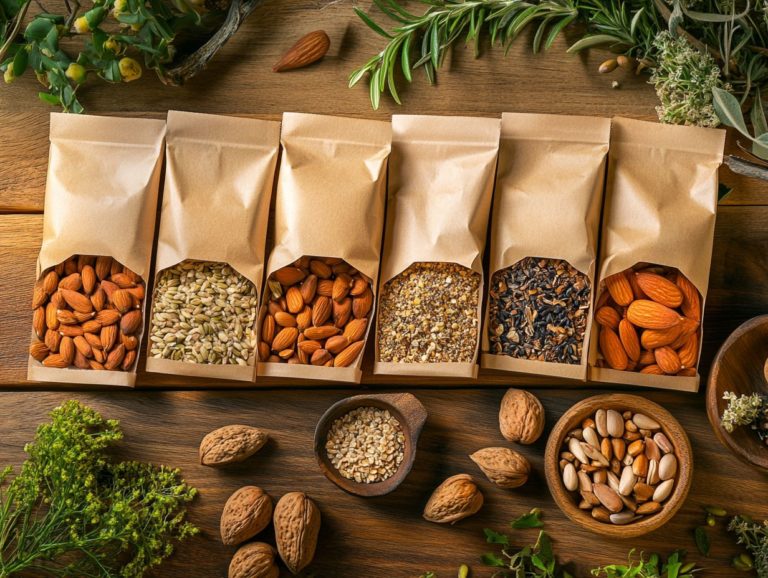Importance of Fiber in a Bird’s Diet
Fiber is essential in a bird’s diet. It significantly influences digestion and overall health.
Learning about soluble and insoluble fiber helps you make the best choices for your bird’s nutrition.
Discover how fiber can transform your bird’s health and happiness! This article highlights the benefits of fiber, identifies the best sources, and offers guidance on ensuring your bird receives the right amount for its well-being.
Contents
- Key Takeaways:
- What is Fiber and Why is it Important for Birds?
- Types of Fiber for Birds
- Benefits of Fiber for Birds
- Improved Digestion and Health in Birds
- Why Fiber Matters
- Sources of Fiber for Birds
- How Much Fiber Should Be Included in a Bird’s Diet?
- Introducing Fiber to a Bird’s Diet
- Frequently Asked Questions
- What is the Importance of Fiber in a Bird’s Diet?
- What Type of Birds Benefit from a High-Fiber Diet?
- How Does Fiber Help Birds Maintain a Healthy Weight?
- Can a Lack of Dietary Fiber in a Bird’s Diet Lead to Health Problems?
- What Are Some Sources of Fiber for Birds, and How Do They Impact Growth Performance?
- How Much Fiber Should Be Included in a Bird’s Diet for Optimal Performance Improvement?
Key Takeaways:

- Fiber is crucial for a bird’s digestion and overall health.
- Both soluble and insoluble fiber play important roles in a bird’s diet.
- To ensure a healthy balance, birds should consume a recommended daily intake of fiber from both natural and commercial sources.
What is Fiber and Why is it Important for Birds?
Fiber serves as a cornerstone of a bird’s diet. It keeps your bird’s gut healthy, aids digestion, and helps them use nutrients better. Additionally, incorporating fresh fruits into their meals is crucial for optimal nutrition.
By grasping the significance of fiber, you can optimize your birds’ diets, ensuring they receive the necessary fiber for improved overall health and vitality. Beyond facilitating the proper functioning of the gastrointestinal tract, fiber also influences the composition of commensal bacteria, bolstering immune functions.
Defining Fiber and its Role in a Bird’s Diet
Fiber is an essential element in your bird’s diet. It plays a pivotal role in maintaining gut health and is key to understanding bird digestive health, ensuring optimal poultry nutrition.
This vital component comes in two main forms: soluble and insoluble fiber. Soluble fiber dissolves in water, creating a gel-like substance that can help regulate blood sugar levels and lower cholesterol. Insoluble fiber adds bulk to the diet, promoting more effective digestion and preventing constipation.
Including both types of fiber is crucial. It aids in breaking down food more efficiently, ensuring that essential nutrients are absorbed and utilized effectively. A fiber-rich diet fosters healthy gut flora, enhancing overall digestive health and leading to improved nutrient absorption key factors in maintaining your birds’ vitality and well-being.
Types of Fiber for Birds
Grasping the various types of fiber available for birds is crucial for enhancing their diets and promoting optimal gastrointestinal health. Incorporating feed additives that encompass both soluble and insoluble fiber can significantly elevate their well-being.
Soluble vs. Insoluble Fiber
Understanding the distinction between soluble and insoluble fiber is important. Each type brings unique advantages for gut health and the production of short-chain fatty acids, which are beneficial for digestion.
Soluble fiber, found in foods like oats, barley, and certain fruits, dissolves in water to form a gel-like substance in the digestive tract. This aids in nutrient absorption and promotes beneficial fermentation by gut microbes. In contrast, insoluble fiber sources such as whole grains, nuts, and vegetables add bulk to the diet, facilitating movement through the intestine, preventing constipation, and enhancing digestion.
Together, these two types of fiber work in harmony, improving gut health while supporting essential physiological functions in birds. This synergy highlights their vital role in maintaining a balanced diet.
Benefits of Fiber for Birds

Incorporating fiber into a bird’s diet can yield a wealth of benefits. You’ll notice improved digestion and health, along with enhanced feed intake.
This simple addition can significantly boost your poultry’s overall performance.
Take a moment today to assess your bird’s fiber intake for a healthier, happier pet!
Improved Digestion and Health in Birds
Why Fiber Matters
Fiber supports gut health in birds by promoting the growth of friendly bacteria. This helps with digestion and prevents issues like constipation.
Research shows that fiber also aids in nutrient absorption and strengthens the gut barrier, which is crucial for overall avian health.
Sources of Fiber for Birds
When you re exploring the best fiber sources for birds, consider both natural and commercial options that can easily fit into their vegetable diet. This will help ensure their dietary fiber needs are met effectively.
Natural vs. Commercial Sources
Natural sources of fiber are plentiful in a variety of seeds and legumes. Commercial options typically come in specialized bird feeds designed to meet the dietary needs of different species.
Incorporating fruits and vegetables like carrots, apples, and leafy greens can enhance fiber intake, aiding digestion and promoting overall health. This combination mimics a bird s natural diet, which is vital for their well-being.
Formulated feeds contain essential vitamins and minerals, ensuring your birds enjoy a balanced diet.
Finding the right balance between natural sources and commercial feeds allows you to create a varied menu that supports not only physical wellness but also behavioral enrichment, catering to your feathered companions’ specific needs.
How Much Fiber Should Be Included in a Bird’s Diet?
Determining the appropriate amount of fiber for a bird’s diet is essential for optimal poultry nutrition. This ensures enhanced performance across various species, leading to healthier, more productive birds.
Recommended Daily Intake

The recommended daily intake of fiber varies by species, but generally, aim for a range of 5-20% of the diet to support optimal poultry nutrition.
For herbivorous birds like parrots and finches, a higher fiber content leaning toward the upper end of this spectrum is ideal for promoting digestive health. Omnivorous species may require slightly less, around 10-15%, to maintain their overall well-being.
When assessing fiber content in diets, analyze ingredients like seeds, grains, and vegetables, as these significantly contribute to total fiber intake. Consider factors such as age; young birds typically need higher fiber for growth. Also, monitor their health status birds with digestive issues may require tailored recommendations to ensure they get enough fiber without overloading their systems.
Introducing Fiber to a Bird’s Diet
When introducing fiber to a bird’s diet, it s essential to make the transition gradually. This helps prevent any digestive disturbances while ensuring your feathered friend maintains optimal feed intake.
Gradual Transition and Monitoring for Changes
A gradual transition is crucial when introducing new fiber sources. Keep a close eye on any changes in how birds digest food and their overall health. This approach minimizes potential digestive stress and helps birds adapt better to the altered diet.
To ensure a successful transition, aim for a timeline of 7 to 14 days. Gradually increase the new fiber sources in the feed. Look for signs of successful adaptation, such as increased feed intake, consistent stool quality, and an overall sense of vitality. These indicators can help you make necessary adjustments during this period.
Establishing monitoring protocols is essential. Focus on daily observations of feed intake and stool consistency. Regularly assess the birds’ behavior and activity levels to confirm that they are thriving and responsive to dietary changes.
Frequently Asked Questions
What is the Importance of Fiber in a Bird’s Diet?
Fiber is essential for a bird’s digestive health. It helps maintain proper digestion and prevents constipation, which is why understanding the importance of variety in bird diet is crucial.
What Type of Birds Benefit from a High-Fiber Diet?
Birds that primarily consume seeds and grains, like parakeets, cockatiels, and finches, greatly benefit from a high-fiber diet.
How Does Fiber Help Birds Maintain a Healthy Weight?
Fiber adds bulk to a bird’s diet, making them feel full without consuming excess calories. This can help prevent obesity and other health issues.
Can a Lack of Dietary Fiber in a Bird’s Diet Lead to Health Problems?
Yes, a low-fiber diet can cause digestive issues like constipation, diarrhea, and even malnutrition. Certain ingredients in bird food can also contain things that make it hard for birds to get the right nutrients.
What Are Some Sources of Fiber for Birds, and How Do They Impact Growth Performance?
Fiber is found in a variety of fruits, vegetables, and leafy greens, as well as in pellets and high-quality bird food. Ingredients like pea hulls, safflower seed, and sunflower seed are excellent sources.
How Much Fiber Should Be Included in a Bird’s Diet for Optimal Performance Improvement?
The recommended amount of fiber in a bird’s diet is between 10-30%, depending on the species and their specific needs. For species like red-winged blackbirds and chickadees, this amount varies. Incorporating probiotics can enhance SCFA production and aid digestion.







